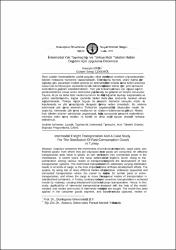| dc.contributor.author | Ergin, Hüseyin | |
| dc.contributor.author | Çekerol, Serap Gülsen | |
| dc.date.accessioned | 2019-10-22T16:59:42Z | |
| dc.date.available | 2019-10-22T16:59:42Z | |
| dc.date.issued | 2008 | |
| dc.identifier.issn | 1302-1842 | |
| dc.identifier.uri | http://www.trdizin.gov.tr/publication/paper/detail/T0RZME5qVTE= | |
| dc.identifier.uri | https://hdl.handle.net/11421/21926 | |
| dc.description.abstract | Lojistik; hammaddeler, yedek parçalar, nihai ürünler olarak ürünlerin çıkış noktasından tüketim noktasına hareketini kapsamaktadır. Etkin bir taşıma hizmeti, ürüne katma değer sağladığı gibi, pazardaki rekabet gücünü de artırmaktadır. Son yıllarda taşıma türleri arasında oluşturulan kombinasyon sayesinde lojistik sektöründe sağlanan katma değer, yeni taşımacılık sistemlerinin gelişimini desteklemektedir. Tüm yük türlerinin taşınması için, değişen dağıtım gereksinimlerine cevap veren intermodal yük taşımacılığı bu gelişimin en önemli sonucudur. Taşıma, iki ya da daha fazla modun kullanımı ile dizilmiş bağlantılı taşımayı kapsamakta ve yükün standartlaştırılmış kaplar içersinde birden fazla taşıma modunda hareket etmesi sağlanmaktadır. Türkiye lojistik boyutu ile taşımacılık hizmetini karayolu modu ile karşılamakta ve yük taşımacılığında dengesiz dağılıma neden olmaktadır. Bu nedenle intermodal yük taşıma sisteminin Türkiye’de uygulanabilirliği, oluşturulan model ile araştırılıp, intermodal yük taşıma modlarının ve rotaların bulunmasına çalışılmıştır. Model, hızlı tüketim ürünleri sektöründe uygulanarak, bulgular sonucunda taşımacılık maliyetlerini minimize eden taşıma modları ile lojistik üs olma özelliği taşıyan stratejik noktalar belirtilmiştir. | en_US |
| dc.description.abstract | Logistics comprises the movements of products-as raw materials, spare parts, and finished goods- from where they are originated to where goods are consumed. An effective transportation adds value to goods, as well as it enhances their competitive power in the marketplace. In recent years, the value added created in logistics sector owing to the combination among various modes of transportation, supports the development of new transportation systems. The intermodal transportation, which addresses varying distribution needs of all kinds of cargo, is the most important outcome of these development efforts. The system, by using two or more different modes of transportation, embraces sequential and connected transportation where the carrier is responsible for certain parts or entire transportation, and allows the cargo to move through several modes of transportation in standardized containers. In Turkey, contrary to developed countries, transportation is achieved mostly by roadway, causing imbalanced distribution of cargo transportation. Hence, in this study, applicability of intermodal transportation is analyzed with the help of the model created, and modes and routes of intermodal transportation are sought. The model has been applied in the consumer goods segment, and based on the data captured, modes of transportation that minimize transportation related costs and strategic points that showed the characteristics of logistic bases have been explained. | en_US |
| dc.language.iso | tur | en_US |
| dc.rights | info:eu-repo/semantics/openAccess | en_US |
| dc.subject | Sosyal Bilimler | en_US |
| dc.subject | Disiplinler Arası | en_US |
| dc.title | Intermodal Yük Taşımacılığı ve Türkiye Hızlı Tüketim Malları Dağıtımı İçin Uygulama Denemesi | en_US |
| dc.title.alternative | Intermodal Freight Transportation and a Case Study for the Distribution of Fast Comsumption Goods in Turkey | en_US |
| dc.type | article | en_US |
| dc.relation.journal | Dumlupınar Üniversitesi Sosyal Bilimler Dergisi | en_US |
| dc.contributor.department | Anadolu Üniversitesi, Porsuk Meslek Yüksekokulu | en_US |
| dc.identifier.volume | 0 | en_US |
| dc.identifier.issue | 22 | en_US |
| dc.identifier.startpage | 207 | en_US |
| dc.identifier.endpage | 230 | en_US |
| dc.relation.publicationcategory | Makale - Ulusal Hakemli Dergi - Kurum Öğretim Elemanı | en_US |


















